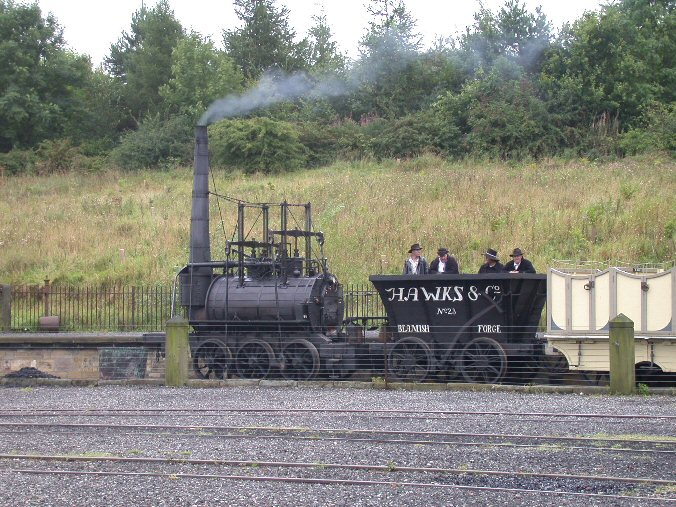Steam Elephant on:
[Wikipedia]
[Google]
[Amazon]
 ''Steam Elephant'' was an early
''Steam Elephant'' was an early
 ''Steam Elephant'' was a six-wheeled locomotive of
''Steam Elephant'' was a six-wheeled locomotive of
 ''Steam Elephant'' was an early
''Steam Elephant'' was an early steam locomotive
A steam locomotive is a locomotive that provides the force to move itself and other vehicles by means of the expansion of steam. It is fuelled by burning combustible material (usually coal, oil or, rarely, wood) to heat water in the loco ...
from North East England
North East England is one of nine official regions of England at the first level of ITL for statistical purposes. The region has three current administrative levels below the region level in the region; combined authority, unitary authori ...
.
Historiography
An illustration of the locomotive first came to modern attention in 1931 and it was then generally assumed to be the work ofGeorge Stephenson
George Stephenson (9 June 1781 – 12 August 1848) was a British civil engineer and mechanical engineer. Renowned as the "Father of Railways", Stephenson was considered by the Victorians a great example of diligent application and thirst f ...
. More recent interpretation is based on research carried out at Beamish Museum
Beamish Museum is the first regional open-air museum, in England, located at Beamish, near the town of Stanley, in County Durham, England. Beamish pioneered the concept of a living museum. By displaying duplicates or replaceable items, it wa ...
for construction of a replica. This interpretation is based largely on contemporaneous paintings (one being the earliest known oil of a steam locomotive, by an unknown artist) and other material from the Museum archives. It is from the paintings that the name ''Steam Elephant'' has become associated specifically with this locomotive.
Description and interpretation
 ''Steam Elephant'' was a six-wheeled locomotive of
''Steam Elephant'' was a six-wheeled locomotive of Stephenson gauge
A standard-gauge railway is a railway with a track gauge of . The standard gauge is also called Stephenson gauge (after George Stephenson), International gauge, UIC gauge, uniform gauge, normal gauge and European gauge in Europe, and SGR in Ea ...
. It was built for the Wallsend Waggonway,
an edge railway now known to have been of gauge.
As with Stephenson's Killingworth locomotives of the year before, it had a centre-flue boiler with two vertical cylinders
A cylinder (from ) has traditionally been a three-dimensional solid, one of the most basic of curvilinear geometric shapes. In elementary geometry, it is considered a prism with a circle as its base.
A cylinder may also be defined as an infini ...
of about set into its top centreline. The cylinders drove slide bar mounted beams which turned crankshafts driving the axles through 2:1 reduction gears between the frames. It had a tall, tapering chimney, the lower part being surrounded by a feedwater heater
A feedwater heater is a power plant component used to pre-heat water delivered to a steam generating boiler. Preheating the feedwater reduces the irreversibilities involved in steam generation and therefore improves the thermodynamic efficiency o ...
. It would have weighed about 7.5 tons and had a top speed of around and a load capacity of about 90 tons over a short distance.
It is now considered to have been designed by John Buddle and William Chapman for the Wallsend Waggonway and colliery at Wallsend
Wallsend is a town in North Tyneside, England, at the eastern end of Hadrian's Wall. It has a population of 43,842 and lies east of Newcastle upon Tyne.
History Roman Wallsend
In Roman times, this was the site of the fort of Segedunum. This ...
on the north bank of the River Tyne in 1815
Events
January
* January 2 – Lord Byron marries Anna Isabella Milbanke in Seaham, county of Durham, England.
* January 3 – Austria, Britain, and Bourbon-restored France form a secret defensive alliance treaty against Pr ...
using metal components supplied by Hawks of Gateshead. It appears originally not to have been very successful at Wallsend, probably due to lack of adhesion on the wooden rails there, nor on trial at Washington. Following the introduction of iron
Iron () is a chemical element with symbol Fe (from la, ferrum) and atomic number 26. It is a metal that belongs to the first transition series and group 8 of the periodic table. It is, by mass, the most common element on Earth, right in ...
rails at Wallsend, it had a working life there longer than many contemporaneous locomotives, until at least the mid-1820s.
There is evidence that it was then rebuilt for use at the Hetton collieries, working there for a further decade.
Replica
''Steam Elephant'' was recreated byBeamish Museum
Beamish Museum is the first regional open-air museum, in England, located at Beamish, near the town of Stanley, in County Durham, England. Beamish pioneered the concept of a living museum. By displaying duplicates or replaceable items, it wa ...
to work with passengers on its standard gauge "Pockerley Waggonway
Wagonways (also spelt Waggonways), also known as horse-drawn railways and horse-drawn railroad consisted of the horses, equipment and tracks used for hauling wagons, which preceded Steam locomotive, steam-powered rail transport, railways. The t ...
" in 2002, being assembled by Alan Keef
Alan Keef Ltd is a British narrow gauge railway engineering company which manufactures, overhauls, and deals in narrow gauge locomotives, rolling stock and associated equipment.
The Limited Company was formed in 1975 at Cote, Bampton, Oxon, ...
.
The replica was designed and built by engineers Ross Clavell, Jim Rees and Potter finished in 1998. Clavell also designed and built the famous weather vane atop the engine shed at Beamish.
References
{{early-steam-locos Early steam locomotives Individual locomotives of Great Britain Steam locomotives of Great Britain Standard gauge locomotives of Great Britain